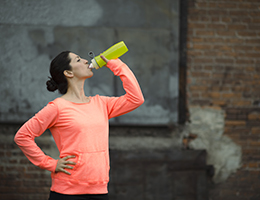
Summer’s arrival means it’s more important than ever to get enough fluids. That’s because the rising temperatures put you at risk for dehydration. That’s what happens when your body can’t adequately replace fluids lost through sweating.
Being even mildly dehydrated can cause a headache or muscle cramps. It can even put you at risk for a potentially life-threatening, heat-related illness like heatstroke. Here’s what you should know about maintaining proper hydration levels.
How much water do you need?
According to the American Academy of Family Physicians (AAFP), water—not sugary drinks, like calorie-rich sodas—is the best drink for staying hydrated. And you may have heard that you need six to eight 8-ounce glasses of water every day to get enough.
That’s a reasonable goal, the AAFP says. Even so, different people need different amounts of water. For example, people who sweat a lot need more than those who don’t. And certain health problems—like diabetes and heart disease—can also increase your fluid needs. So can being overweight.
Thinking beyond water
But drinking water isn’t the only way to stay hydrated. You can also get water from food, especially produce. In fact, many fruits and veggies are more than 90% water. They include summertime favorites like strawberries, cantaloupe, watermelon, tomatoes, cucumbers and zucchini.
Sports drinks with electrolytes may also be a good choice if you exercise vigorously in very hot weather, the American Heart Association (AHA) advises.
However you choose to replenish your fluids, don’t wait until you’re thirsty to do so. By the time your mouth is dry, you’re already dehydrated, the AHA cautions.
And that’s true even if you’ve only been sitting in the summer sun. You don’t have to be physically active to become dehydrated in hot weather.
Protect yourself
So take precautions: Carry a water bottle filled with ice-cold water all day long and drink often.
Know the red flags of dehydration too. Urine color is an easy one to spot. Pale and clear means you’re well hydrated, the AHA says. Dark urine means you need to drink more.
Watch out for other warning signs too, like a headache, muscle cramps, dizziness, nausea or vomiting. Be sure to seek help for symptoms of severe dehydration, like confusion or weakness.
Original source: https://pennstatehershey.netreturns.biz/HealthInfo/Story.aspx?StoryId=0f4727b5-5963-4e89-a593-1aa5fc6aecf2#.XllaBKhKi70